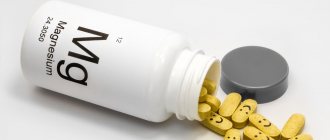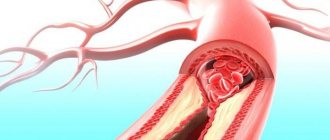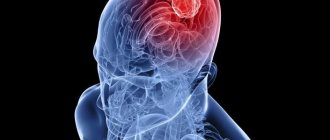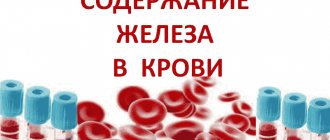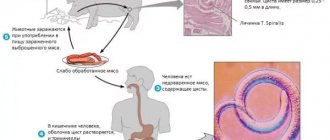Irina Ivanova
Hematologist
Higher education:
Hematologist
Samara State Medical University (SamSMU, KMI) Level of education - Specialist 1993-1999
Additional education:
“Hematology”
Russian Medical Academy of Postgraduate Education
Contacts
The degrees of iron deficiency anemia reflect the condition of the body. Anemia is a pathological clinical and hematological condition in which there is a drop in the concentration of red blood cells and hemoglobin in the blood. Anemia is not an independent pathology. This is a clear manifestation of the underlying disease.
Diagnosis and treatment of iron deficiency
In simple words, it is a lack of iron mineral in the body.
But why is it so important?... Iron is necessary for the production of hemoglobin - a substance in red blood cells that transports oxygen throughout the body and carbon dioxide.
If you are deficient in iron, your body must work harder to obtain the necessary energy to transport that same oxygen. Imagine, you need to supply every cell of your body with it.
Otherwise, lack of iron in the body will eventually lead to decreased red blood cell production and iron deficiency anemia. And that is not all.
According to a website about a healthy lifestyle, the most well-known consequence of iron deficiency is anemia.
First of all, its lack negatively affects the immune system, a person begins to get tired faster, children’s ability to learn worsens, and endurance decreases. Researchers report that many cases of stomach cancer have been linked to a lack of iron in the body.
But then what is the daily dose and the reasons for the lack of iron in the body?...
If any of the above symptoms apply to you, then you may have an iron deficiency. The best way to find out is to go to your doctor for a blood test.
They may prescribe medications or certain vitamins and nutritional supplements. Therefore, in this case, it will be important for you to follow your doctor's advice.
But as the medical portal advises, in case of iron deficiency anemia it is necessary to take additional blood tests for iron. These include: serum iron, ferritin, total serum iron binding capacity (TIBC) and transferrin. Based on all these indicators, the doctor can determine not only the type of anemia, but also its latent form even before symptoms appear.
If the results are normal and you do not experience the symptoms that we talked about above, then this indicates a good level of iron in your body.
To solve this problem, you will also most likely have to take care of your diet. Look for some iron-rich foods. ...
Treatment methods
Iron supplements are used to eliminate iron deficiency anemia. For 2-3 months, medications are used in a volume of 100-200 mg per day. After this, the dosage is reduced, leaving 30-60 mg of the drug for 2-4 months. At the first stage, intensive iron saturation is carried out to increase the amount of hemoglobin in the blood. The second stage is considered supportive, the third is used to replenish reserves in the liver.
Unfortunately, it is impossible to cope with anemia without taking medications.
Hypochromic, posthemorrhagic and other types of iron deficiency anemia are treated with the following drugs:
- maltofer - can be used in the form of tablets, syrup, drops, solution for injection;
- tardiferon – used in tablet form;
- sorbifer durules - available exclusively in tablet form;
- ferroplex – used in the form of dragees;
- ferrum-onion - used in the form of tablets, syrup and solution for injection;
- totem - produced in the form of a solution for internal use.
As a rule, the listed medications are used before meals, if the person does not suffer from gastritis or peptic ulcer. You should not take medications with foods that can bind iron - these include tea, milk, coffee.
Don't worry if your teeth darken some time after using the medications - this is a common side effect after such medications. Digestive disturbances and nausea may also occur.
How to increase iron in the blood?
It is believed that the total amount of iron in the human body ranges from two to seven grams, which depends on the gender, weight and age of the person.
The remaining part of the iron is instantly converted into hemosiderin or ferritin (protein compounds), which are deposited in the tissues in the form of reserves, and when the body experiences a deficiency in the microelement, it extracts them from there.
The body itself does not produce iron: this trace element comes with food and is absorbed in the intestines (which is why low amounts of the trace element are often associated with intestinal tract problems). Iron then ends up in plasma, the liquid part of the blood.
Then about eighty percent of the trace element is included in hemoglobin, which is an integral part of the red blood cell. Here, iron is responsible for adding oxygen and carbon dioxide to hemoglobin. This microelement attaches oxygen to itself in the lungs. Then, as part of hemoglobin, which is located inside red blood cells, it is sent to the cells, transfers oxygen to them, and attaches carbon dioxide to itself. After this, the red blood cell is sent to the lungs, where the iron atoms easily part with carbon dioxide.
It is interesting that iron acquires the ability to attach and detach gases only when it is part of hemoglobin. Other compounds that contain this microelement do not have this ability.
About ten percent of iron is part of myoglobin, which is found in myocardial muscle and skeletal muscles. Myoglobin binds oxygen and stores it. If the body begins to experience oxygen starvation, this gas is extracted from myoglobin, passes into the muscles and participates in further reactions. Therefore, when for some reason the blood supply to any part of the muscle is disrupted, the muscle still receives oxygen for some time.
Iron is also part of other substances, and together with them participates in hematopoiesis, the production of DNA, and connective tissue. Takes part in lipid metabolism, oxidative reactions, regulates the neutralization of poisons by the liver, and promotes energy metabolism. The thyroid gland needs this element for the synthesis of hormones that are involved in many metabolic processes. The role of iron during pregnancy is important: the baby’s body uses it to build its tissues.
It has long been noted that a lack of iron in the body negatively affects the functioning of the nervous system. And all because this element is involved in the transmission of signals between brain cells. This microelement also increases the body’s resistance to disease and relieves fatigue. Therefore, when it is lacking, a person often feels powerless.
You can increase the level of iron in the blood through a balanced diet and medications. The patient should include foods that contain sufficient amounts of iron in their diet. Among the “record-breaking” products are red varieties of lean meat, liver and poultry. The trace element is also found in plant foods - buckwheat, apples and pomegranates.
Often, a diet rich in iron is not enough to replenish it in the body. If necessary, the doctor will select medications, determine their dosage and duration of use. You should not decide this issue on your own, since the wrong dosage can lead to an excess of iron. It is also harmful to the human body, as is its deficiency. Let's take a closer look at the options for drug therapy.
In a situation where a patient has a critically low level of iron in the blood, he requires immediate restoration of hemoglobin. For these purposes, drugs are used in the form of injections. They are also prescribed for the treatment of chronic iron deficiency anemia. Examples of drugs:
- iron hydroxide sucrose complex;
- iron sorbitol complex with citrate in dextrin solution, containing 100 mg of iron;
- iron hydroxide dextran.
If iron deficiency is not critical, then the doctor selects drugs with a prolonged action. These include: ferric chloride, ferrous fumarate or sulfate, as well as its hydroxide polymaltosate. It is acceptable to prescribe vitamin complexes containing the necessary macro- and microelements in their composition. So, in combination with the microelement in question, the patient can take manganese and copper gluconate, ascorbic acid or vitamins B 9 and 12.
Separately, biological food additives should be highlighted. Patients are often interested in the question: does hematogen help maintain normal iron levels? Yes, this healthy product can have a beneficial effect on iron levels in the body. However, its isolated use cannot lead to an increase in the level of the substance.
You should not start using it yourself without your doctor’s permission. Since hematogen contains sugar, which may be a contraindication or limitation for people with diabetes.
Complications and prognosis
Anemia is a serious illness, dangerous not only for its course, but also for the development of complications. Iron deficiency causes muscle weakness and atrophic changes in the mucous membranes. An unmotivated fever (up to 37.5 degrees) is considered a short-term complication of iron deficiency anemia. It quickly disappears after taking iron supplements.
Advanced forms of pathology necessarily affect internal organs. This is associated with disruption of intracellular metabolism, atrophy, sclerosis and tissue degeneration. In patients with the disease, the functioning of the cardiovascular system is disrupted (myocardial dystrophy, non-coronary ischemia, poor blood flow occurs). Pathology significantly impairs the functioning of the nervous system.
With timely and consistent therapy, doctors note a favorable prognosis for the disease. Iron deficiency anemia significantly impairs organ function, which can be fatal.
Reasons for high values
The daily requirement for iron in children depends on their age:
- in the first year of life - from 4 milligrams per day at the age of 0-3 months to 10 milligrams at the age of 7-12 months;
- at the age of 1-6 years - 10 milligrams;
- at the age of 7-10 years - 12 milligrams;
- at the age of 11-17 years - 15 milligrams for boys and 18 milligrams for girls.
The daily requirement for iron in an adult varies significantly depending on gender:
- for men - 10 milligrams per day;
- girls and women of the childbearing period, due to regular menstrual blood loss, need to receive 18-20 milligrams of iron;
- During pregnancy and breastfeeding, the need for this element almost doubles.
One of the US clinics, as well as the medical portal EuroLab, list the following main causes of iron deficiency in the human body:
- Blood loss – this can occur as a result of gastrointestinal bleeding, peptic ulcers or colorectal cancer; or due to heavy menstrual periods.
- Lack of iron in your diet is when you don't get enough iron from the food you eat.
- Inability to absorb iron is caused by intestinal disorders such as celiac disease or those associated with intestinal surgery. They can also affect your body's ability to absorb nutrients from digested food.
- Pregnancy is probably the most joyful reason for many women. But remember that during pregnancy, women should consume more iron than usual to improve their levels and those of the baby. It is very important!
Well, everything is probably clear, except for the most important thing - how to understand that you are suffering from iron deficiency, what are the main signs of iron deficiency in the body?
Let's figure it out together...
So, let's list some of the signs of low iron levels, or iron deficiency anemia.
Remember, you often have to remove whole bunches of hair from your comb after caring for your head. Right? ... But sometimes it takes on a scary look.
In fact, iron deficiency is one of the main reasons for hair loss in women, along with thyroid problems, as well as a lack of certain other minerals in the diet.
The reason is simple: iron deficiency, especially when anemia progresses, leads to a state where our body simply survives. Instead of supplying our hair with oxygen, we sometimes just kill it.
The good news for you is that this condition can be easily treated by introducing iron-rich foods into your diet plan.
Also keep an eye on your nails. Their health is also iron deficiency.
ABOUT
about 60% women
complain about the condition of their hair and spend huge sums on its treatment, while the main cause of brittle ends is most often within us.
The leading doctor of the American clinic, Ruben Bogin, notes that often the cause of deterioration of hair in young girls is a lack of iron in the body. He explains this by saying that when health problems arise, the body immediately mobilizes, “getting rid” of everything unnecessary: it reduces the nutrition of nails, hair, etc., which leads to a deterioration in their condition.
Although most people think that dizziness is common due to heredity, it can actually mean
completely different
.
This unpleasant sensation can sometimes be a side effect of iron deficiency.
This occurs because dizziness is a result of poor oxygen supply to the brain. Namely, iron, as we already know, is necessary for the effective supply of oxygen to various parts of the body.
When interpreting the results, it is very important to take into account what time of day the material was taken: the iron content in the body fluctuates greatly throughout the day. It is known that iron concentrations are higher in the morning than in the evening.
You should also know that the concentration of iron in the blood depends on many reasons: on the functioning of the intestines, on the amount of microelement reserves that are stored in the spleen, bone marrow and other organs, as well as on the production and breakdown of hemoglobin in the body. Iron leaves the body in different ways: with feces, urine, and even in nails and hair.
That is why, if the body does not have enough iron, disorders are observed in the functioning of many organs and systems. Therefore, microelement deficiency is indicated by the following symptoms:
- increased fatigue, feeling of weakness, fatigue;
- increased heartbeat, shortness of breath;
- irritability;
- dizziness;
- migraines;
- cold fingers and toes;
- pale skin, brittle nails, hair loss;
- pain or inflammation of the tongue;
- strong desire to move your legs (restless legs syndrome);
- poor appetite, craving for unusual foods.
If you notice such symptoms, you must take a test to determine the level of iron in the blood. If the study shows its deficiency, the reason must be found out as quickly as possible (especially if we are talking about pregnancy or a growing child’s body).
There is no need to be alarmed right away: in many situations, iron deficiency is caused by poor nutrition. For example, its deficiency is recorded in vegetarians, in people who adhere to a dairy diet (calcium interferes with the absorption of the microelement), as well as in those who are addicted to fatty foods. Also, the body has little iron during a fast. After correcting the diet and taking vitamin and mineral supplements, its concentration returns to normal.
A small amount of iron in the body may be due to the body’s increased need for this trace element. This primarily applies to small children under two years of age, adolescents, and women during pregnancy and lactation.
Sometimes iron deficiency can be triggered by stressful situations and a weakened nervous system. In this case, you need to put it in order and avoid stress.
Iron deficiency can cause various diseases. Among them:
- Iron deficiency anemia, caused by diseases of the gastrointestinal tract that interfere with the normal absorption of the microelement in the intestine. This could be gastritis, enteritis, enterocolitis, various tumors in the stomach and intestines, operations to remove part of the small intestine or stomach.
- The presence of inflammation, purulent-septic and other infections.
- Osteomyelitis (purulent infection affecting bone tissue).
- Myocardial infarction.
- An increased amount of iron-containing pigment hemosiderin (formed during the breakdown of hemoglobin or with intensive absorption of iron from the intestine).
- A problem with the synthesis of the hormone erythropoietin in the kidneys due to chronic renal failure or other diseases of this organ.
- Rheumatism.
- Iron is excreted quickly in the urine due to nephrotic syndrome.
- Bleeding of various types.
- Enhanced hematopoiesis, which uses iron.
- Cirrhosis.
- Benign and oncological tumors, especially fast-growing ones.
- Stagnation of bile in the biliary tract.
- Deficiency of vitamin C, which promotes the absorption of iron.
Due to the fact that iron deficiency can be caused by various reasons, if a lack of a microelement is detected, the doctor will refer you for further examination. You need to go through it as quickly as possible, since among the diseases that cause iron deficiency in the blood, there are deadly ailments. And only then, according to the results of the analysis, will he prescribe treatment and prescribe the necessary medications.
Often a woman may not be aware of a lack of iron in the blood. However, its long-term deficiency will eventually lead to the manifestation of typical symptoms:
- dizziness and frequent headaches;
- general weakness and low concentration;
- fast fatiguability;
- blueness under the eyes;
- constant drowsiness;
- desire to eat chalk, earth, raw meat, etc.;
- noise in ears;
- pallor;
- dry skin, brittle hair and nails;
- frequent cracks in the corners of the lips.
Men experience similar symptoms, along with decreased immunity and a change in the perception of odors (unpleasant odors begin to seem pleasant). Since physical activity in men is more pronounced than in women, the lack of iron in the body is more pronounced and somewhat more difficult to cope with.
In children, chronic microelement deficiency can manifest itself in worsening academic performance and memory loss. Strange taste preferences may occur. For example, a child begins to taste chalk. Critically low iron in the blood is characterized by more pronounced symptoms (severe drowsiness, fainting, etc.).
In order to promptly suspect a deficiency of the microelement in question, you should take a general blood test once every 6 months.
It is often discovered that there is a lot of iron in the blood if a person uncontrollably takes various multivitamins and medications with a high iron content.
Sometimes drinking water and excessive consumption of iron-containing foods lead to this. But the main reasons that cause high levels of the element are somatic diseases and genetic disorders.
- When the gene responsible for metabolism with the presence of Fe is dysfunctional, it is not absorbed in the body, and excess iron accumulates in organs and tissues. In such a case, primary hemochromatosis, a genetic disease, is diagnosed. This pathology affects the liver, heart muscle, spleen, and pancreas, which causes the development of severe forms of heart failure, edema, liver cirrhosis, diabetes mellitus, and joint diseases.
- Kidney damage such as nephritis impairs the utilization of blood elements and they remain in the plasma, gradually breaking down and releasing iron.
- Acute and chronic forms of hepatitis, in which there is a large amount of bilirubin in the blood.
- Thalassemia is a disease that is inherited when the synthesis of dimeric hemoglobin is replaced by tetrameric hemoglobin.
Classification of the disease
Before treating iron deficiency anemia, it is important to determine the complexity of the disease. Considering the level of hemoglobin, there are several degrees of it:
- mild, in which hemoglobin is up to 90 g/l;
- average degree - up to 70 g/l;
- severe anemia - less than 70 mg/l.
The clinical picture of the pathology (symptoms of hypoxia) does not always correspond to the severity of the disease. Therefore, a clinical classification has been developed based on the severity of anemia. The clinical classification identifies five main degrees of severity of the disease:
- Anemia without clinical signs is the primary form of the disease. The first clinical changes in hematological tests do not appear (as compensatory mechanisms are triggered).
- Moderate manifestations of the disease - general weakness increases, specific symptoms appear (sideropenia, B12 deficiency).
- Severe symptoms of iron deficiency anemia in women and men. Patients begin to complain of palpitations, shortness of breath, and dizziness.
- Anemic precoma.
- Anemic coma.
A precomatose, comatose state develops in a matter of hours, regardless of the cause of iron deficiency anemia. The risk group includes the following persons:
- premature babies;
- teenagers;
- donors;
- with nutritional dystrophy;
- pregnant women.
Such patients are recommended to undergo periodic screening examinations. To do this, the morphological characteristics of peripheral blood erythrocytes are assessed, and a computer analysis of blood parameters is performed.
How much microelement should there be?
In the male body, the reserves of this microelement are higher than in women, and range from 500 to 1.5 thousand mg. For women, this figure ranges from 300 to 1 thousand mg. At the same time, doctors claim that the vast majority of the population has iron reserves at a minimum. That is why during pregnancy, when the body requires iron in large quantities, iron deficiency may occur, and doctors prescribe vitamin and mineral preparations for prevention.
To find out whether there is a lack of iron in the body, it is necessary to do a biochemical blood test. The material for the study is taken from a vein, then fibrinogen is removed from the plasma (so that the blood does not clot during the study), and serum is obtained. Such a sample is convenient to use when studying the composition of blood.
Thus, the norm of serum iron in the blood of a healthy person should correspond to the following values:
- up to 1 year: 7.16 – 17.9 µmol/l;
- from 1 to 14 years: 8.95 – 21.48 µmol/l;
- in women over 14 years of age, including during pregnancy: 8.95 – 30.43 µmol/l;
- in men after 14 years: 11.64 – 30.43 µmol/l.
In the female body, its amount is less than in men. In women of reproductive age, iron concentration depends on menstruation. In the second half of the cycle, the levels of this microelement reach their highest values; after menstruation, its level decreases significantly, which is associated with blood loss during menstruation.
But at the same time, the body’s need for this microelement increases, and therefore it is necessary to ensure that during pregnancy a sufficient amount of iron is supplied with food. This is due to the fact that not only the mother’s body needs this microelement, but also the baby’s. Therefore, at a certain stage of its development, it begins to very quickly take it in large quantities.
That is why the doctor recommends a special diet during pregnancy and also prescribes the use of special vitamin and mineral preparations. Thanks to this, the body is provided with all the necessary substances during pregnancy. After childbirth, the acute need for iron, as during pregnancy, disappears. But is it worth it to stop taking vitamin and mineral supplements, the doctor must say.
Signs of the latent stage
Dry throat is a sign of latent deficiency
The latent stage of iron deficiency - sideropenic syndrome - is a process that does not immediately, but gradually leads to IDA.
In a clinical blood test, hemoglobin will still be within normal limits, but iron levels will already decrease. A little later, an anemic syndrome of mild severity occurs, in which hemoglobin does not drop below 100-110 g/l.
Hidden iron deficiency primarily leads to damage to the skin and its appendages. Clinically this will be expressed as follows:
- dryness and peeling of the skin with the formation of cracks; fragility, thinning hair and hair loss; koilonychia - concavity of the nails;
- atrophic glossitis - inflammation of the tongue with a change in taste perception, an increase in its size, pain, redness;
- atrophic rhinitis, the appearance of a craving for various atypical odors - paint, acetone, gasoline, etc.;
- dryness in the throat, atrophy of the esophageal mucosa and the formation of cracks, which leads to discomfort during swallowing and dysphagia;
- atrophic gastritis.
Muscle weakness in the latent stage
Since the lack of myoglobin increases in parallel, patients will complain of:
- general muscle weakness;
- decreased performance;
- involuntary urination during the daytime when coughing, laughing, crying;
- difficulty passing food through the esophagus;
- the appearance of fainting, especially when moving from a horizontal to a vertical position;
- discomfort in the heart area, fluctuations in blood pressure, rapid pulse, as hypoxia leads to disruption of its contractile function.
Symptoms of iron deficiency in the body in women
The optimal amount of metal in the human body is 4-5 grams, but sometimes its level varies. Increased iron levels are less common than iron deficiency, but the consequences are more severe.
With an excess of this element, a person experiences the following sensations:
- fatigue, headache, dizziness;
- heartburn, nausea accompanied by vomiting, disruption of the gastrointestinal tract;
- itching on the body;
- weight loss, lack of appetite.
In addition, there is a risk of developing diabetes mellitus, arthritis, atherosclerosis, cardiovascular diseases, infections, and liver pathologies. Unnatural pigmentation appears on the palms and armpits, and the liver enlarges.
When such symptoms appear, a test is prescribed to determine the composition of the blood and identify diseases that provoke the pathology.
Symptoms of iron deficiency anemia
Patients with iron deficiency anemia report general weakness, fatigue, difficulty concentrating, and sometimes drowsiness. Headache and dizziness appear. Severe anemia may cause fainting. These complaints, as a rule, do not depend on the degree of decrease in hemoglobin, but on the duration of the disease and the age of the patients.
Iron deficiency anemia in women is also characterized by changes in the skin, nails and hair. The skin is usually pale, sometimes with a slight greenish tint (chlorosis) and with an easy blush on the cheeks, it becomes dry, flabby, peels, and cracks easily form. Hair loses its shine, turns grey, thins, breaks easily, thins and turns gray early. Changes in nails are specific: they become thin, matte, flattened, easily peel and break, and striations appear. With pronounced changes, the nails acquire a concave, spoon-shaped shape (koilonychia). Patients with iron deficiency anemia experience muscle weakness, which is not observed in other types of anemia. It is classified as a manifestation of tissue sideropenia. Atrophic changes occur in the mucous membranes of the digestive canal, respiratory organs, and genital organs. Damage to the mucous membrane of the digestive canal is a typical sign of iron deficiency.
There is a decrease in appetite. There is a need for sour, spicy, salty foods. In more severe cases, distortions of smell and taste (pica chlorotica) are observed: eating chalk, lime, raw cereals, pogophagia (craving for eating ice). Signs of tissue sideropenia quickly disappear after taking iron supplements.
Fatigue
Are you exhausted, weak and often irritable?
I'm not saying that you may not have gotten enough sleep because you went to bed late. This refers to continuous fatigue that lasts for several weeks or even months.
Prolonged fatigue is one of the main symptoms of iron deficiency.
Fatigue occurs because the body does not have enough red blood cells to carry oxygen to its parts and organs.
Of course, fatigue can be the result of many other reasons besides iron deficiency. This could be: alcohol abuse, medication, too much caffeine, stress at work or depression, as well as other medical problems.
Fatigue can also be a consequence of a lack of such an important mineral as magnesium, which is involved in most biochemical reactions in the body. A deficiency of this mineral can often even lead to death.
But fatigue can also be caused
excess iron
in blood.
Diagnostics
Poikilocytosis is a diagnostic sign of iron deficiency
The first and mandatory study is a general analysis of peripheral blood, which will reveal:
- microcytosis - reduced size of red blood cells from 8 microns in combination with normal cells;
- hemoglobin level is below 130-120 g/l;
- hypochromia - pallor of red blood cells when stained;
- poikilocytosis - detection of red blood cells of various shapes;
- decrease in the number of red blood cells;
- decrease in the average volume of red blood cells;
- increased concentration of platelets and leukocytes;
- decreased reticulocyte levels;
- decrease in color index and hematocrit;
- increased erythrocyte sedimentation rate.
Additional manipulations are prescribed:
- stool examination for occult blood,
- fibrogastroduodenoscopy,
- MRI or CT,
- X-ray examination of the lungs and stomach.
The importance of diet
To increase iron in the blood, it is very important not only to take prescribed medications, but also to pay attention to your diet. A menu aimed at increasing iron levels in the blood should include the consumption of lean beef, lamb, veal, rabbit, fish, turkey or goose. Pork contains little trace element, so nutritionists do not recommend using it to increase iron.
Buckwheat, oatmeal, beans, nuts, and oysters help increase iron in the blood. The diet should contain fresh vegetables and fruits, which contain not only iron, but also vitamin C, which promotes the absorption of this microelement.
It is important to understand that diet alone is not enough to increase iron in the blood if the problem is caused by illness. Even if the food contains the required amount of a microelement, this will not be enough if the body does not absorb it enough due to illness or there are problems due to which the microelement is consumed in increased quantities.
Therefore, it is very important to follow all the doctor’s instructions, take the medications prescribed by him, including following the dosage. Under no circumstances should you increase or decrease the dose of medications on your own.
Vegetarianism
The body gets iron from a variety of sources. Moreover, due to the consumption of meat, fish, poultry, this element is absorbed 2-3 times better and in larger quantities than from vegetables, fruits, etc. If you are a vegetarian, try to eat dark green greens, legumes, and grains. Be sure to combine them with foods rich in vitamin C (sweet peppers, berries, broccoli), this is how iron absorption increases.
Avoid contact with the offender, and other ways to reduce aggression in your direction
After the scandal, Channel One will test a new rating system on “The Voice”
Constantly bring out emotions: signs of painful dependence on a partner
Skin and Eye Problems
It turns out that sometimes pale skin can tell you that you don't have enough iron in your body.
Anemia is one of the most common causes of pale skin.
In some cases, due to iron deficiency, you may suffer from cracking of the skin near the corners of the mouth or even an irritating skin condition that causes itching.
Iron deficiency can even affect your eye color!
According to research published in the Journal of General Medicine, pale eyes are one of the most common signs of anemia, even if there are no other symptoms.
Restless legs syndrome
As the medical journal points out, restless legs syndrome has several names that you may also come across: Willis disease, Ekbom disease.
All these conditions lead to very unpleasant sensations in the legs or arms and force them to constantly move, resulting in sleep disturbances. The most interesting thing is that these movements cause relief.
This picture is classified as a neurological disease, which indicates iron deficiency or anemia.
Anxiety, stress and depression
Lack of iron can contribute to the development or worsening of each of the following anxiety disorders: depression, stress, and persistent worrying.
One study in Japan found that the absence or low amount of vitamin B6 and iron in the body caused such panic attacks that participants ended up requiring emergency treatment.
Who would have thought? ...
So know this: B vitamins and iron play an important role in the production of the hormone serotonin, which regulates both mood and sleep.
.
Another study published in the Journal of Nutrition found a strong relationship between iron deficiency and anxiety and depression in new mothers. Moreover, supplemental iron resulted in a 25% improvement in these symptoms.
Take note of this information!
Feeling cold
If you, even now, are the only person in the room who is sitting huddled from the cold in a warm sweater, you should think about it. Perhaps you simply do not have enough iron.
So in the United States they conducted an experiment in which six women took part, whose diet was low in iron for six months. Their resistance to cold was measured by the time they sat in a swimsuit in a cold room and leaving when they began to shiver.
The same women then ate iron-rich foods for 100 days. Then they were asked to go into the same cold room again in a swimsuit. Not only were they able to withstand the cold
8 minutes
more this time, but their core body surface temperature dropped to only half of what they had in the first experiment.
Of course, feeling cold can be related to many other symptoms, including your diet, which is low in healthy fats. Keep this in mind for the future.
Enhance Iron Absorption
Two hours before eating meat and for two hours after, avoid tea, coffee, foods high in fiber and fiber (bran, raw cabbage salads), eggs, chocolate, dairy products and calcium supplements - they all reduce iron absorption.
Vitamin C with bioflavonoids, vitamin B12, folic acid, and copper enhance the absorption of iron.
Weakening - excess calcium, zinc, vitamin E, phosphates, medications that reduce stomach acidity (some drugs for the treatment of ulcers and gastritis) and phytic acid, which is found in walnuts, almonds, legumes, whole grains and bran. It's time to remind you that we do not recommend that everyone give up these healthy products. The diet needs to be adjusted only for those who have been tested and are convinced of iron deficiency.
Dietary foods rich in iron
There are actually two different types of iron:
- derived from animal products
- derived from plant food sources that forms the bulk of most dietary sources of iron
Foods that are richest (3.5 mg or more) in iron include:
- 100 gr. beef or chicken liver
- 100 gr. shellfish such as mussels and oysters
- Cup of cooked beans, which are also excellent sources of fiber
- Half a cup of tofu
- 100 gr. pumpkin or sesame seeds
Good sources of iron (2.1 mg or more) include:
- 100 gr. canned sardines in oil
- 100 gr. boiled beef or turkey
- half cup canned beans, red beans, or chickpeas
- one medium baked potato
- one medium stalk of broccoli
- cup of dried apricots
Other sources (0.7 mg or more) of iron are:
- 100 gr. chicken breast
- 100 gr. fish: halibut, haddock, salmon, tuna or other red fish
- 100 gr. nuts: walnuts, pistachios, almonds, which are sometimes called the healthiest food on earth, or cashews
- cup of spinach
- cup durum wheat pasta or brown rice
- medium green pepper
When your diet is rich in foods low in iron, you may be at risk. This is especially true for women who are overweight vegetarians or pregnant women!
Want to know the secret to getting more iron from your diet?
It's quite simple!
Add more foods that are sources of vitamin C to your iron-rich meal plan. Add more citrus fruits (lemon, lime, orange) and of course some green vegetables.
You can simply squeeze some lemon juice onto your green salad or pour it over your steamed fish. YOU can also steam your favorite broccoli and add some nuts or seeds to this dish.


